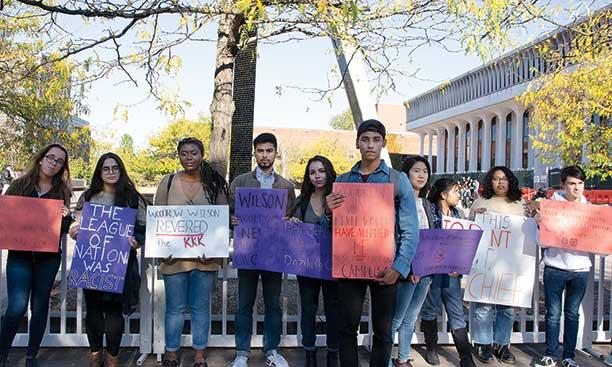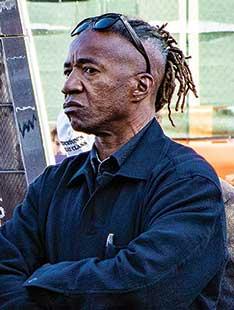
A debate that was central to a student takeover of President Eisgruber ’83’s Nassau Hall office four years ago was rekindled in October, as the University dedicated a sculpture commissioned to address the good and the bad of the legacy of Woodrow Wilson 1879.
The 39-foot-high installation, called Double Sights, “is disruptive by design,” Eisgruber said during the Oct. 5 ceremony. He said it “exposes the profound contradictions in Wilson’s life and character, and in so doing it challenges us to confront the fault lines in our society and the tensions within the human soul.”
Those fault lines were evident as more than 100 protesters, many holding signs citing Wilson’s racial views, gathered silently around the marker in Scudder Plaza during the dedication. After the ceremony concluded, they filled the area to speak with a bullhorn about what some said was a monument to Wilson.
“We are here today because there is nothing complex about a white supremacist,” said KiKi Gilbert ’21, a student organizer and protest leader. “We are here because the University has decided to commemorate a racist without any regret.”
The installation, designed by 2019 MacArthur Fellow Walter Hood, features a slanted white column rested on a straight black column etched with quotes from Wilson as well as faces and quotes from figures who were critical of him. (The full text can be found at doublesights.princeton.edu.)
A special committee of the University trustees recommended that a marker addressing Wilson’s legacy be constructed as a response to concerns raised in 2015 by the Black Justice League, a student group that protested Wilson’s history of racism and called for his name to be removed from the Woodrow Wilson School of International and Public Affairs.
Brent L. Henry ’69, vice chair of the board of trustees, explained how the marker came to be during a public conversation before the dedication titled “Woodrow Wilson’s Legacy: Wrestling with History.” “We decided that on balance, rather than erase [Wilson’s] name from Princeton, that we should preserve it, but also explain it,” Henry said. “And that’s what we’re doing today.”
Hood and Michele Minter, vice provost for institutional equity and diversity, participated in the conversation, which took place during the Thrive conference celebrating black alumni.
Hood said the project was one of the most difficult of his career, and he acknowledged the role of student activists in leading to its creation. “It’s a spatial piece — it’s not a monument,” he said, describing it as an “anti-monument.”
“This should be a place of protest,” Hood added. “This should be a place where you go to be heard. And at night, it should become a gathering space. A beacon of hope, I hope; a beacon of strength.”
Double Sights does not mark the end of the work that needs to be done, Minter said. “We have to keep talking about Woodrow Wilson forever,” she said. “And if we ever get comfortable, then we have failed.”
Alumni had mixed feelings. “We live in a world filled with contradictions, and how we work through them matters,” Rahsaan Harris ’95 said. “I’m glad the conversation is ongoing, that the University has responded, and that students are responding.”
But some like Mariel Calloway ’11 found the series of events to be unsettling. “I’m really surprised at the level of passion and intensity and how raw this still is,” she said. “The fact that it is still so inflamed is troubling to me.”

